C++学习 --- 模板
1、模板的概念
模板就是建立通用的模具,大大提高复用性。
生活中的模板:
一寸照模板

PPT模板:框架美观,填充“肉”即可。等。
模板通用性很强,不可以直接使用,只是一个框架。
模板并不是万能的。

2、函数模板
2.1、函数模板语法
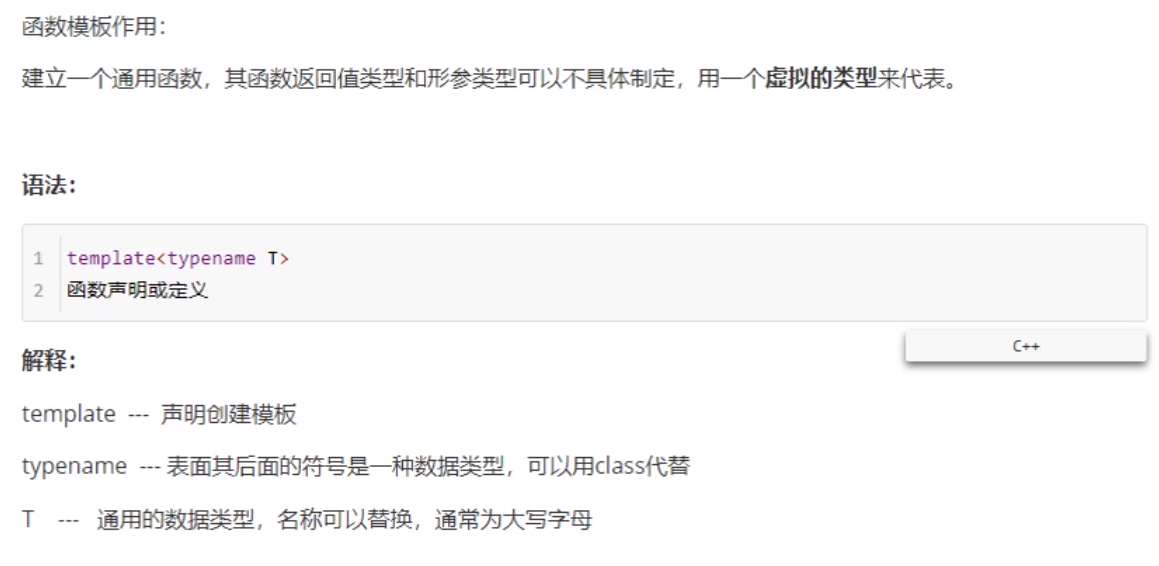
#include <iostream> using namespace std; //函数模板 //声明一个模板,告诉编译器后面代码中紧跟的T不要报错,T是通用的数据类型 template<typename T> void mySwap(T &a, T &b) { T temp = a; a = b; b = temp; } //两个整形交换的函数 void swapInt(int &a, int &b) { int temp = a; a = b; b = temp; } //交换两个浮点型的函数 void swapDouble(double &a, double &b) { double temp = a; a = b; b = temp; } void test01() { int a = 10; int b = 20; /*swapInt(a,b); cout << "a = " << a << endl; cout << "b = " << b << endl; double c = 1.1; double d = 2.2; swapDouble(c, d); cout << "c = " << c << endl; cout << "d = " << d << endl;*/ //利用函数模板来交换 //两种方式来使用模板 //1.自动类型推导 mySwap(a,b); cout << "a = " << a << endl; cout << "b = " << b << endl; //2.显示指定类型 mySwap<int>(a, b); cout << "a = " << a << endl; cout << "b = " << b << endl; } int main() { test01(); system("pause"); return 0; }

2.2、函数模板注意事项

#include <iostream> using namespace std; //函数模板注意事项 //1、自动类型推导,必须推导出一致的数据类型T才可以使用 template<typename T> //typename 可以替换成class void mySwap(T &a, T &b) { T temp = a; a = b; b = temp; } void test01() { int a = 10; int b = 20; char c = 'c'; //正确 mySwap(a, b); //错误,推导不出一致的T类型 //mySwap(a, c); cout << "a = " << a << endl; cout << "b = " << b << endl; } //2、模板必须要确定出T的数据类型,才可以使用 template <class T> void func() { cout << "func 调用" << endl; } void test02() { func<int>(); //显示指出这个T是int,否则无法调用该函数 } int main() { test01(); test02(); system("pause"); return 0; }
2.3、函数模板案例

#include <iostream> using namespace std; //实现通用 对数组进行排序的函数 //规则 从大到小 //算法 选择 //测试 char 数组 、int 数组 //交换函数模板 template<class T> void mySwap(T &a, T &b) { T temp = a; a = b; b = temp; } //排序算法模板,选择排序 template<class T> void mySort(T arr[],int len) { for (int i = 0; i < len; i++) { //认定最大值的下标 int max = i; for (int j = i + 1; j < len; j++) { //认定的最大值比遍历出的数值要小,说明j下标的元素才是真正的最大值 if (arr[max] < arr[j]) { //更新最大值下标 max = j; } } if (max != i) { //交换max 和 i 下标元素 mySwap(arr[i],arr[max]); } } } //打印数组模板 template<class T> void printArray(T arr[], int len) { for (int i = 0; i < len; i++) { cout << arr[i] << " "; } cout << endl; } void test01() { //测试char数组 char charArr[] = "aebfcd"; int num = sizeof(charArr) / sizeof(char); mySort(charArr, num); printArray(charArr,num); } void test02() { //测试char数组 int intArr[] = {7,2,3,6,5,8,10}; int num = sizeof(intArr) / sizeof(int); mySort(intArr, num); printArray(intArr, num); } int main() { test01(); test02(); system("pause"); return 0; }
2.4、普通函数与函数模板的区别

#include <iostream> using namespace std; //普通函数与函数模板的区别 //1、普通函数调用可以发生隐式类型转换的 //2、函数模板 用自动类型推导,不可以发生隐式类型转换 //3、函数模板 用显示指定类型,可以发生隐式类型转换 //普通函数 int myAdd01(int a,int b) { return a + b; } template<class T> T myAdd02(T a, T b) { return a + b; } void test01() { int a = 10; int b = 20; char c = 'c'; // 'c'-->99 cout << myAdd01(a, c) << endl; //自动类型推导,不可以发生隐式类型转换 //cout << myAdd02(a, c) << endl; //显示指定类型,可以发生隐式类型转换 cout << myAdd02<int>(a, c) << endl; } int main() { test01(); system("pause"); return 0; }
总结:建议使用显示指定类型的方式,调用函数模板,因为可以自己确定通用类型T
2.5、普通函数与函数模板的调用规则

#include <iostream> using namespace std; //普通函数与函数模板的调用规则 //1、如果函数模板和普通函数都可以调用,优先调用普通函数 //2、可以通过空模板参数列表 强制调用 函数模板 //3、函数模板也可以发生函数重载 //4、如果函数模板可以产生更好的匹配,优先调用函数模板 void myPrint(int a, int b) { cout << "调用的是普通函数" << endl; } template<class T> void myPrint(T a, T b) { cout << "调用的是函数模板" << endl; } template<class T> void myPrint(T a, T b,T c) { cout << "调用的是重载函数模板" << endl; } void test01() { int a = 10, b = 20; //优先调用普通函数 //myPrint(a,b); //通过空模板参数列表 强制调用 函数模板 //myPrint<>(a, b); //函数模板也可以发生函数重载 //myPrint(a,b,100); //如果函数模板可以产生更好的匹配,优先调用函数模板 char c1 = 'a'; char c2 = 'b'; myPrint(c1,c2); } int main() { test01(); system("pause"); return 0; }

2.6、模板的局限性

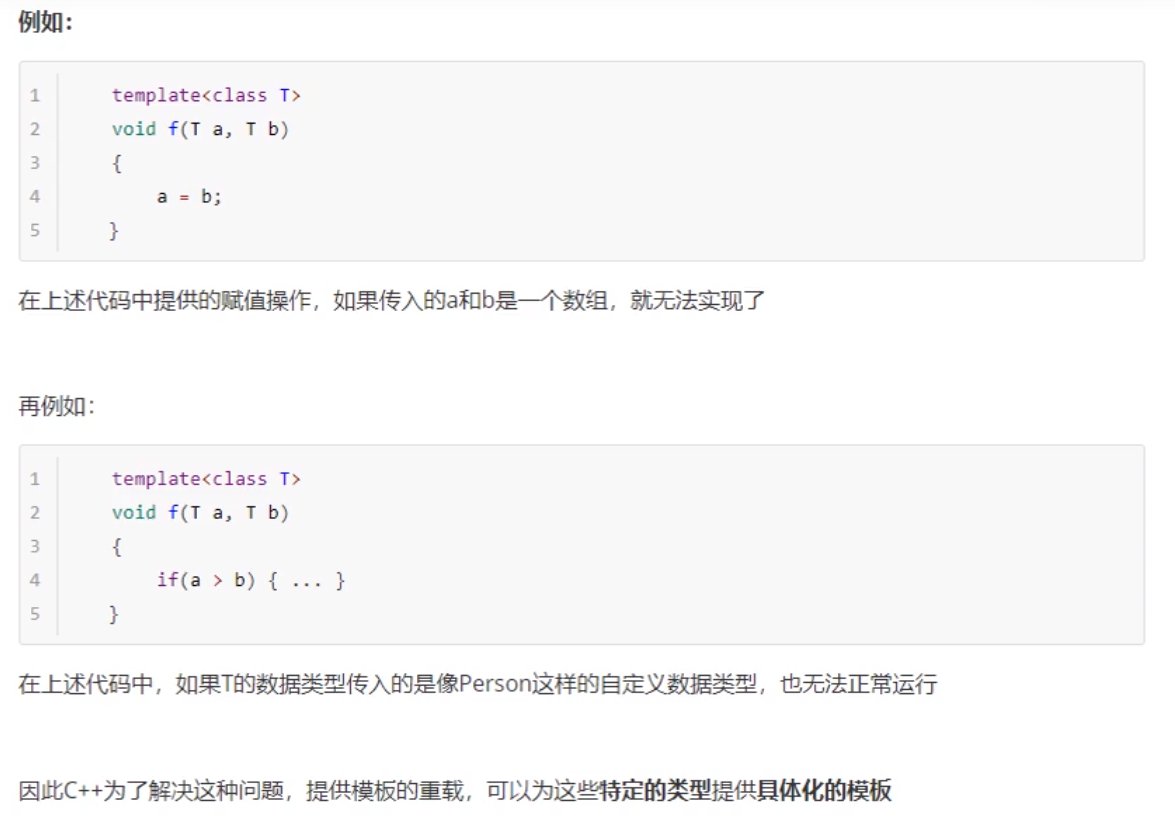
#include <iostream> using namespace std; //模板的局限性 //模板并不是万能的,有些特定数据类型,需要具体化方式做特殊实现 class Person { public: Person(string name, int age) { this->m_Name = name; this->m_Age = age; } //姓名 string m_Name; //年龄 int m_Age; }; //对比两个数据是否相等 template<class T> bool myCompare(T &a, T &b) { if (a == b) { //解决方法1:运算符重载 return true; } else { return false; } } //解决方法2:提供Person类型的重载版本,优先调用 template<> bool myCompare(Person &p1, Person &p2) { if (p1.m_Name == p2.m_Name && p1.m_Age == p2.m_Age) { //解决方法1:运算符重载 return true; } else { return false; } } void test01() { int a = 10; int b = 20; bool ret = myCompare(a,b); if (ret) { cout << "a == b" << endl; } else { cout << "a != b" << endl; } } void test02() { Person p1("Tom", 10); Person p2("Tom", 11); bool ret = myCompare(p1,p2); if (ret) { cout << "p1 == p2" << endl; } else { cout << "p1 != p2" << endl; } } int main() { test01(); test02(); system("pause"); return 0; }

3、类模板
3.1、类模板语法
类模板的作用:
建立一个通用类,类中的成员数据类型可以不具体制定,用一个虚拟的类型来代表。
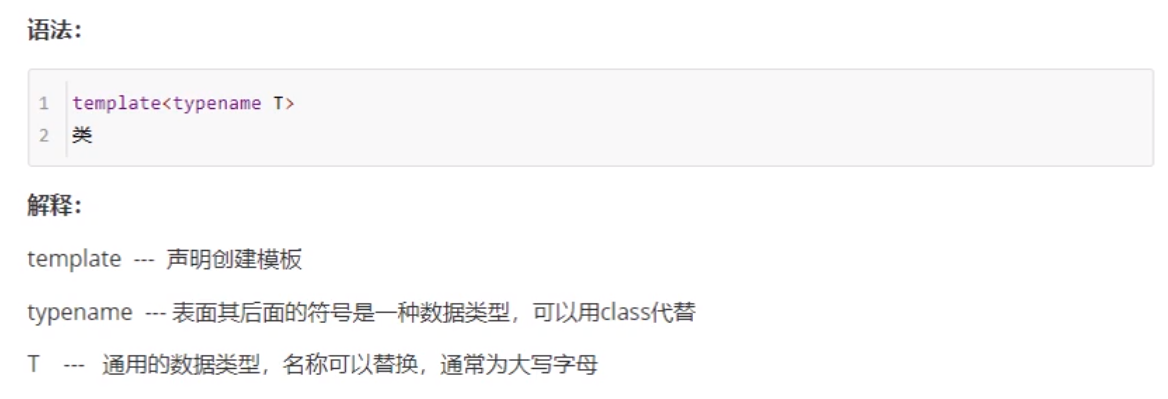
#include <iostream> #include <string> using namespace std; //类模板 class后面是通用数据类型 template<class NameType,class AgeType> class Person { public: Person(NameType name, AgeType age) { this->m_Name = name; this->m_Age = age; } void showPerson() { cout << "name:" << this->m_Name << "\t" << "age:" << this->m_Age << endl; } NameType m_Name; AgeType m_Age; }; void test01() { //类型参数化 Person<string, int> 模板参数列表 Person<string, int> p1("孙悟空",999); p1.showPerson(); } int main() { test01(); system("pause"); return 0; }

3.2、类模板与函数模板区别

#include <iostream> #include <string> using namespace std; //类模板与函数模板区别 template<class NameType,class AgeType = int> class Person { public: Person(NameType name, AgeType age) { this->m_Name = name; this->m_Age = age; } void showPerson() { cout << "name:" << this->m_Name << "\t" << "age:" << this->m_Age << endl; } NameType m_Name; AgeType m_Age; }; //1.类模板没有自动类型推导使用方式 void test01() { //无法用自动类型推导 //Person p("孙悟空", 1000); Person<string, int> p1("孙悟空",999); p1.showPerson(); } //2.类模板在模板参数列表中可以有默认参数 //template<class NameType,class AgeType = int> void test02() { Person<string> p("猪八戒",200); p.showPerson(); } int main() { test01(); test02(); system("pause"); return 0; }
3.3、类模板中成员函数创建时机

#include <iostream> #include <string> using namespace std; //类模板中成员函数创建时机 //类模板中成员函数在调用时才去创建 class Person1 { public: void showPerson1() { cout << "Person1 show" << endl; } }; class Person2 { public: void showPerson2() { cout << "Person2 show" << endl; } }; template<class T> class MyClass { public: //类模板中的成员函数 void func1() { obj.showPerson1(); } void func2() { obj.showPerson2(); } //以上两个成员函数在调用时候才去创建 T obj; }; void test01() { //MyClass<Person1> m; MyClass<Person2> m; //m.func1(); m.func2(); } int main() { test01(); system("pause"); return 0; }
3.4、类模板对象做函数参数

#include <iostream> #include <string> using namespace std; //类模板的对象做函数参数 template<class T1,class T2> class Person { public: Person(T1 name, T2 age):m_Name(name), m_Age(age) {} void showPerson(){ cout << "姓名:" << this->m_Name << "\t" << "年龄:" << this->m_Age << endl; } T1 m_Name; T2 m_Age; }; //1、指定传入类型 void printPerson1(Person<string, int> &p) { p.showPerson(); } void test01() { Person<string, int> p("孙悟空", 100); printPerson1(p); } //2、参数模板化 template<class T1,class T2> void printPerson2(Person<T1, T2> &p) { p.showPerson(); cout << "T1的类型为:" << typeid(T1).name() << endl; cout << "T2的类型为:" << typeid(T2).name() << endl; } void test02() { Person<string, int> p("猪八戒", 90); printPerson2(p); } //3、整个类模板化 template<class T> void printPerson3(T &p) { p.showPerson(); cout << "T 的数据类型:" << typeid(T).name() << endl; } void test03() { Person<string, int> p("唐僧", 30); printPerson3(p); } int main() { test01(); test02(); test03(); system("pause"); return 0; }

3.5、类模板与继承

#include <iostream> #include <string> using namespace std; //类模板与继承 template<class T> class Base { T m; }; //错误,必须要知道父类中的T类型,才能继承给子类 //class Son :public Base { //正确 class Son :public Base<int> { }; //如果像灵活之类父类中T类型,子类也需要变类模板 template<class T1,class T2> class Son2 :public Base<T2> { public: Son2() { cout << "T1的类型为:" << typeid(T1).name() << endl; cout << "T2的类型为:" << typeid(T2).name() << endl; } T1 obj; }; void test01() { Son s1; } void test02() { //父类中的T是char,自身的是int Son2<int, char> S2; } int main() { test01(); test02(); system("pause"); return 0; }

3.6、类模板成员函数类外实现

#include <iostream> #include <string> using namespace std; //类模板成员函数类外实现 template<class T1,class T2> class Person { public: Person(T1 name, T2 age); void showPerson(); T1 m_Name; T2 m_Age; }; //构造函数的类外实现 template<class T1,class T2> Person<T1,T2>::Person(T1 name, T2 age):m_Name(name),m_Age(age){} //成员函数的类外实现 template<class T1,class T2> void Person<T1,T2>::showPerson() { cout << "姓名:" << this->m_Name << "\t" << "年龄:" << this->m_Age << endl; } void test01() { Person<string, int> P("Tom", 20); P.showPerson(); } int main() { test01(); system("pause"); return 0; }

3.7、类模板分文件编写
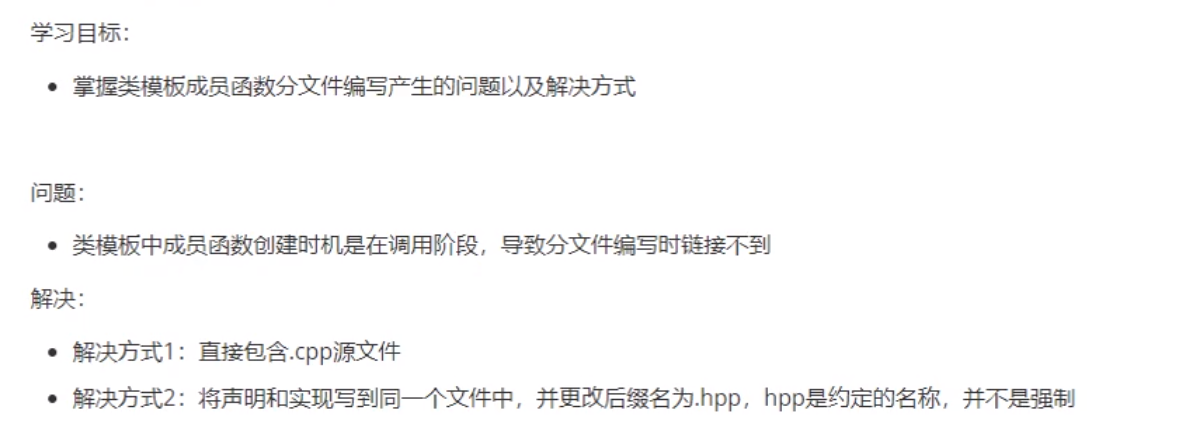
//类模板分文件编写.cpp //问题提出:当做分文件编写时,出现无法解析外部命令,类模板成员函数创建时机是在调用阶段 //第一种解决方式直接包含源文件,一般不用 //#include "person.cpp" //第二种解决方式,将.h .cpp 中的内容写在一起,将后缀名改为.hpp,一看就知道是类模板 #include "person.hpp" void test01() { Person<string, int> p("Jerry", 18); p.showPerson(); } int main() { test01(); system("pause"); return 0; }
//person.hpp #pragma once #include <iostream> #include <string> using namespace std; template<class T1, class T2 > class Person { public: Person(T1 name, T2 age); void showPerson(); T1 m_Name; T2 m_Age; }; template<class T1, class T2> Person<T1, T2>::Person(T1 name, T2 age) :m_Name(name), m_Age(age) {} template<class T1, class T2> void Person<T1, T2>::showPerson() { cout << "姓名:" << this->m_Name << "\t" << "年龄:" << this->m_Age << endl; }

3.8、类模板与友元
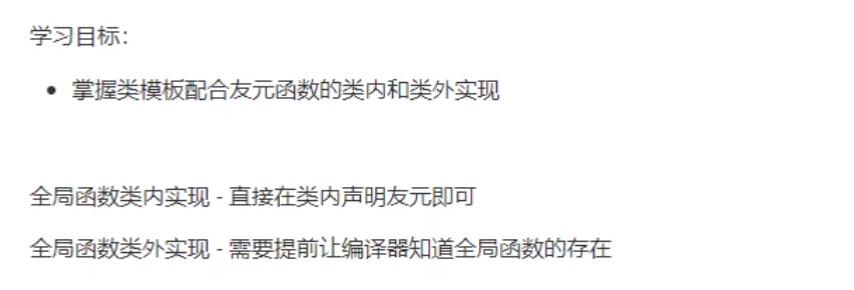
#include <iostream> #include <string> using namespace std; //类外实现 //提前知道person 类 template<class T1,class T2> class Person; //提前知道函数模板 template<class T1, class T2> //让编译器知道T1,T2存在 void printPerson2(Person<T1, T2> p) { cout << "类外实现: " << endl; cout << "姓名:" << p.m_Name << "\t" << "年龄:" << p.m_Age << endl; } //通过全局函数打印Person的信息 template<class T1,class T2> class Person { //全局函数 类内实现 friend void printPerson(Person<T1, T2> p) { cout << "姓名:" << p.m_Name << "\t" << "年龄:" << p.m_Age << endl; } //全局函数类外实现 //加空模板的参数列表 //若全局函数是类外实现,需要让编译器知道这个函数的存在 friend void printPerson2<>(Person<T1, T2> p); public: Person(T1 name, T2 age) { this->m_Name = name; this->m_Age = age; } private: T1 m_Name; T2 m_Age; }; //全局函数在类内实现的测试 void test01() { Person<string, int> p("Tom", 20); printPerson(p); } //全局函数在类外实现的测试 void test02() { Person<string, int> p("Jerry", 21); printPerson2(p); } int main() { test01(); test02(); system("pause"); return 0; }

3.9、类模板案例
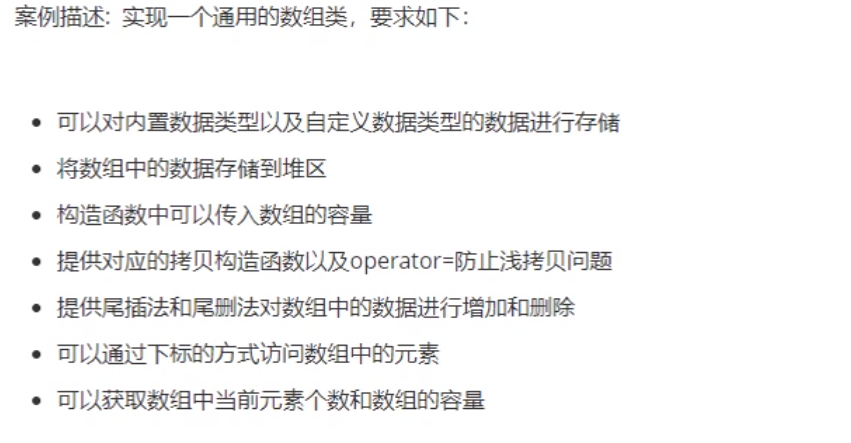

//MyArray.hpp #pragma once #include <iostream> #include <string> using namespace std; //自己的通用数组类 template<class T> class MyArray { public: //有参构造 参数 容量 MyArray(int capacity) { cout << "MyArray 有参构造调用!" << endl; this->m_Capacity = capacity; this->m_Size = 0; this->pAddress = new T[this->m_Capacity]; } //拷贝构造函数 MyArray(const MyArray & arr) { cout << "MyArray 拷贝构造调用!" << endl; this->m_Capacity = arr.m_Capacity; this->m_Size = arr.m_Size; //this->pAddress = arr.pAddress; //浅拷贝 //深拷贝 this->pAddress = new T[arr.m_Capacity]; //将arr中的数据都拷贝过来 for (int i = 0; i < this->m_Size; i++) { this->pAddress[i] = arr.pAddress[i]; } } //operator= 防止浅拷贝问题 //返回引用 用于连等的情况 MyArray& operator=(const MyArray & arr) { cout << "MyArray operator=调用!" << endl; //先判断原来堆区是否有数据,如果有先释放 if (this->pAddress != NULL) { delete[] this->pAddress; this->pAddress = NULL; this->m_Capacity = 0; this->m_Size = 0; } //深拷贝 this->m_Capacity = arr.m_Capacity; this->m_Size = arr.m_Size; this->pAddress = new T[this->m_Capacity]; for (int i = 0; i < this->m_Size; i++) { this->pAddress[i] = arr.pAddress[i]; } return *this; } //尾插法 void Push_Back(const T &val) { //先判断容量是否已经等于大小 if (this->m_Capacity == this->m_Size) { return; } //在数组的末尾插入数据 this->pAddress[this->m_Size] = val; //更新数组大小 this->m_Size++; } //尾删法 void Pop_Back() { //用户访问不到最后一个元素,即为尾删法,逻辑删除 if (this->m_Size == 0) { return; } this->m_Size--; } //通过下标方式访问数组中的元素 //若返回作为左值存在,需要用引用的方式返回 T & operator[](int index) { return this->pAddress[index]; } //返回数组的容量 int getCapacity() { return this->m_Capacity; } //返回数组的大小 int getSize() { return this->m_Size; } //析构函数 ~MyArray() { if (this->pAddress != NULL) { cout << "MyArray 析构调用!" << endl; delete[] this->pAddress; this->pAddress = NULL; } } private: T * pAddress; //指针指向堆区开辟的真实数组 int m_Capacity;//数组容量 int m_Size; //数组大小 };
//MyArrayTest.cpp #include <iostream> #include <string> #include "MyArray.hpp" using namespace std; void printIntArray(MyArray<int> &arr) { for (int i = 0; i < arr.getSize(); i++) { cout << arr[i] << " "; } cout << endl; } void test01() { MyArray<int> arr1(5); for (int i = 0; i < 5; i++) { //尾插法插入数据 arr1.Push_Back(i); } cout << "arr1 的打印输出为:" << endl; printIntArray(arr1); cout << "arr1 的容量为:" << arr1.getCapacity() << endl; cout << "arr1 的大小为:" << arr1.getSize() << endl; MyArray<int> arr2(arr1); cout << "arr2 的打印输出为:" << endl; printIntArray(arr2); //尾删法 arr2.Pop_Back(); cout << "arr2 的尾删后为:" << endl; printIntArray(arr2); cout << "arr2 的容量为:" << arr2.getCapacity() << endl; cout << "arr2 的大小为:" << arr2.getSize() << endl; MyArray<int> arr3(100); arr3 = arr1; } //测试自定义数据类型 class Person { public: Person() {}; Person(string name,int age) { this->m_Name = name; this->m_Age = age; } string m_Name; int m_Age; }; void printPersonArray(MyArray<Person> &arr) { for (int i = 0; i < arr.getSize(); i++) { cout << "姓名:" << arr[i].m_Name << "\t" << "年龄:" << arr[i].m_Age << endl; } } void test02() { MyArray<Person> arr(10); Person p1("孙悟空",999); Person p2("韩信",23); Person p3("妲己",24); Person p4("赵云",21); Person p5("安其拉",22); //将数据插入到数组中 arr.Push_Back(p1); arr.Push_Back(p2); arr.Push_Back(p3); arr.Push_Back(p4); arr.Push_Back(p5); //打印 printPersonArray(arr); cout << "arr 的容量:" << arr.getCapacity() << endl; cout << "arr 的大小:" << arr.getSize() << endl; } int main() { test01(); test02(); system("pause"); return 0; } /* MyArray 有参构造调用! arr1 的打印输出为: 0 1 2 3 4 arr1 的容量为:5 arr1 的大小为:5 MyArray 拷贝构造调用! arr2 的打印输出为: 0 1 2 3 4 arr2 的尾删后为: 0 1 2 3 arr2 的容量为:5 arr2 的大小为:4 MyArray 有参构造调用! MyArray operator=调用! MyArray 析构调用! MyArray 析构调用! MyArray 析构调用! MyArray 有参构造调用! 姓名:孙悟空 年龄:999 姓名:韩信 年龄:23 姓名:妲己 年龄:24 姓名:赵云 年龄:21 姓名:安其拉 年龄:22 arr 的容量:10 arr 的大小:5 MyArray 析构调用! 请按任意键继续. . . */



